Top 10 conservation stories
Mount Revelstoke National Park
National parks protect some of Canada’s most diverse and spectacular natural environments. The breathtaking scenery and inspiring natural surroundings in national parks provide the perfect setting for tuning into nature, learning about it, appreciating it, respecting it and pledging to protect it.
In order to ensure national parks remain healthy and unimpaired for future generations, Parks Canada is working to maintain or restore the ecological health of national parks. Here are some of our success stories:
Coeur d’Alene Salamander
Mapping Caribou Habitat
Solving the Mystery of DDT in Alpine Lakes
Hemlock Looper and Forest Health
Monitoring Ecological Health
Music to the ears – bird monitoring in Mount Revelstoke National Park
Linking the Past to the Present: Subalpine Plant Monitoring in Mount Revelstoke National Park
Students Support Ecological Integrity Through Site Restoration
DNA Wolverine Monitoring
Studying Forest Fire Ecology
Coeur d’Alene Salamander

Coeur d'Alene Salamander
©Parks Canada
The Coeur d’Alene salamander is listed as a species of special concern in the federal Species at Risk Act. This small, nocturnal amphibian lives on land, has no lungs and breathes through its skin, making it particularly vulnerable to environmental disturbances.
Since 2004, this species has been monitored along the Meadows in the Sky Parkway in Mount Revelstoke National Park in order to understand its behaviour, dispersal and habits, so it can be better protected. The parkway is closed to the public each evening. Research demonstrates that road closures, particularly on rainy nights, have had a positive impact on salamander populations. These results help guide management decisions on parkway use and development. Special evening events for visitors are now planned during the hours and conditions when salamanders are least active on the parkway.
Through the continued monitoring of the Coeur d’Alene salamander in Mount Revelstoke National Park, Parks Canada makes adaptive management decisions that will help ensure its longevity.
Mapping Caribou Habitat

Woodland caribou
©Parks Canada
Since the 1990s, southern mountain woodland caribou populations have been declining and are listed as a threatened species under the Canadian Species at Risk Act. The Columbia South herd’s range overlaps both Mount Revelstoke and Glacier national parks and adjacent provincial lands.
In 2004, Parks Canada began a partnership with the Province of British Columbia and several forestry companies to map important caribou habitat in order to better understand where and how caribou use the landscape in the Columbia Mountains. These maps are used by Parks Canada as a basis for caribou conservation efforts including seasonal area closures, redirecting recreation from areas used by caribou and managing forest fires to minimize impacts to caribou habitat. The maps identify the Mt. Klotz area in Mount Revelstoke National Park as important caribou wintering habitat. As caribou are particularly vulnerable to displacement from human activity, the area is now closed to winter recreation.
The benefits of this decision are already apparent; this year, four caribou, including a calf, were seen in the closed area. Parks Canada cannot recover the Columbia South herd of woodland caribou on its own. This is why Parks Canada staff are committed to continued work with the Province of British Columbia, First Nations, industry and the public to develop land-use management policies, both inside and outside national parks, to support the conservation of woodland caribou.
Solving the Mystery of DDT in Alpine Lakes
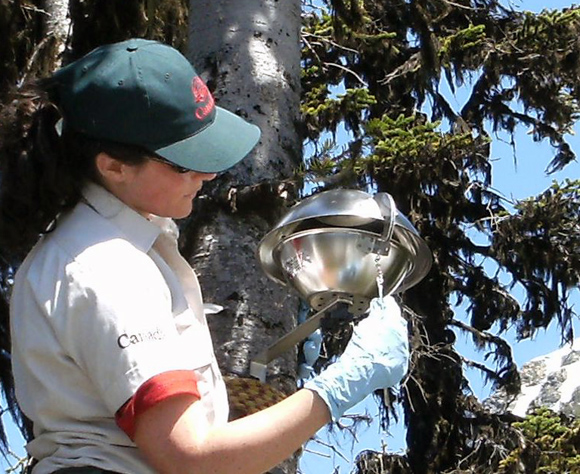
Using passive air samplers to help identify the source of DDT in alpine lakes
©Parks Canada
Mount Revelstoke National Park is known for its colourful alpine wildflower meadows and pristine alpine lakes. But beginning in the 1930s, the lakes were stocked with non-native fish in an effort to improve fishing opportunities. Fish stocking ceased in the 1970s. In the late 1990s, research revealed concentrations of DDT in alpine areas in Canada, such as the high alpine lakes in Mount Revelstoke National Park. Environment Canada research confirmed concentrations of DDT in the fish in the park’s alpine lakes. Where did the DDT come from and what can be done about it?
To help identify the source of DDT, Parks Canada is taking part in the Environment Canada global atmospheric passive sampling (GAPS) program. Parks Canada set up a passive air sampler at Miller Lake to determine local DDT air concentrations and deposition rates. So far, the source of DDT in the alpine lakes of Mount Revelstoke National Park is still unknown. It is suspected that it may have arrived by air from other areas in British Columbia or even other continents.
In order to protect human health, Parks Canada informed the public and staff about the issue and limited fishing in these lakes to catch and release. Following this, Parks Canada and the Environmental Sciences Group analysed sediment from the lakes and determined the risks to people, raptors, waterfowl and other wildlife did not pose a consumption danger. This research is on-going as Parks Canada and partners continue to research the mystery of DDT deposition.
Hemlock Looper and Forest Health
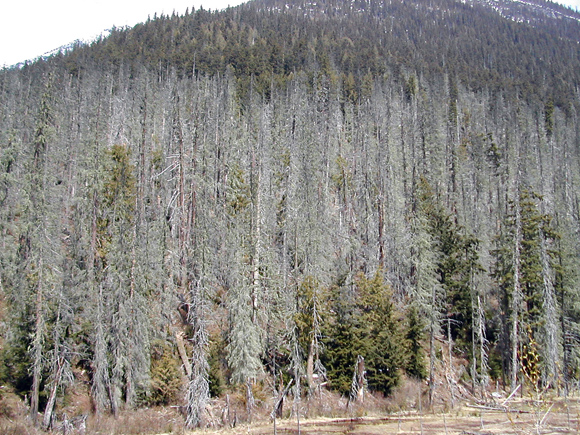
Hemlock looper outbreak
©Parks Canada - Mike Morris
In 2002, an outbreak of mountain pine beetle severely affected a large area of forest in the Interior of British Columbia. At the same time, an outbreak of another insect, the western hemlock looper, was taking place in the Columbia Mountains, including Mount Revelstoke and Glacier national parks.
This insect feeds primarily on the leaves and needles of trees. A severe outbreak can completely strip trees in one season and cause tree mortality, even altering or killing patches of forest. Periodic insect outbreaks occur naturally and contribute to long-term forest health. However, an infestation could have severe and widespread effects on forests, including negative impacts to the forestry industry and on woodland caribou habitat.
In an effort to better understand these winged insect, Parks Canada staff began a collaborative research project to assess how hemlock looper outbreaks affect forest health and whether they degrade caribou habitat.
After three years of studying the frequency and severity of the last outbreak, followed by monitoring forest regeneration, it was determined that most forests can survive looper infestations and that woodland caribou are usually not affected by the disturbance. This research is critically important to managing forest health, especially for the next outbreak which is forecast to occur in Mount Revelstoke and Glacier national parks in 2012.
Monitoring Ecological Health

Monitoring water quality
©Parks Canada
Parks Canada has implemented an Ecological Integrity Monitoring Program for all mountain national parks including Mount Revelstoke and Glacier national parks. In 2005, after several years of work and significant investment, Parks Canada unveiled a new monitoring system for assessing the ecological health of national parks. This is the first time Parks Canada has attempted to create a monitoring system that is consistent across the network. Consistent reports on the ecological state of the parks are produced in a rational and systematic way to support decision-making.
Each park monitors elements that are common nationally and unique to their respective ecosystems. Examples include water quality, airborne pollutants, wildlife populations, bird diversity, amphibian populations, invasive plants, glacier recession and rates of wildfire. Built into this system is extensive scientific review, affordability analysis and public involvement. Over the long term, it assesses ecological health and guides ecosystem management in the mountain parks.
The results of ecological monitoring are valuable, too, in educating Canadians about the nature of mountain ecosystems and the effects – whether positive or negative – of human choices and activities on the health of our national parks.
Music to the ears – bird monitoring in Mount Revelstoke National Park
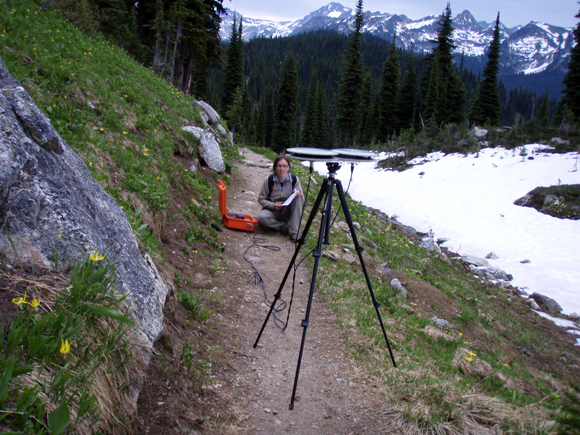
Monitoring birds with sound technology
©Parks Canada
Many bird species are in danger of disappearing throughout the world as more and more of them are found on rare and threatened species’ lists. With their small size, hours of activity and mobility, monitoring birds is no easy feat. Employing the use of new sound technology to assist in monitoring birds like the endangered Olive-sided Flycatcher, Parks Canada helped develop and test a Marantz digital recording unit and a radially directional microphone that can record sound 360 degrees—Mother Nature’s surround sound.
Parks staff and volunteers set up sound stations throughout Glacier and Mount Revelstoke national parks. Microphones record the sound of the environment allowing researchers to record and identify birds at any time, in many locations. The recordings are collected and analysed and the results are music to the ears. This sound technology provides more accurate and complete data sets about where different species prefer to live, eat, mate, raise their young and how they respond to disturbances like noise from human activity.
Parks Canada will continue to use this technology to monitor these species to determine whether improvements made to their habitats could increase populations of threatened birds in Mount Revelstoke and Glacier national parks.
Linking the Past to the Present: Subalpine Plant Monitoring in Mount Revelstoke National Park
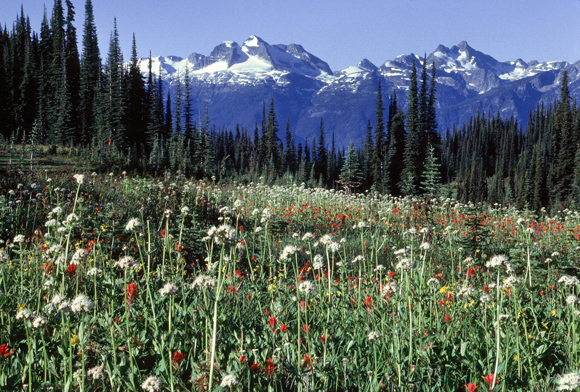
Wildflower meadow at Mount Revelstoke
©Parks Canada
Mount Revelstoke National Park owes much of its reputation as a place of enormous beauty thanks to its many subalpine meadows on the summit of Mount Revelstoke. Visitors from around the world have enjoyed these lush meadows since the park’s creation in 1914. Unfortunately, the vegetation, including beautiful wildflowers, was exposed to trampling and uprooting, leaving noticeable scars. In order to better understand the ecology of plant communities in the area and visitation impacts, research was required.
In response, Environment Canada, with the help of Parks Canada, conducted an ecological assessment of the subalpine meadows in 1974. Since that time, better trail networks, signage and interpretive information directing and educating human use on this sensitive terrain have been implemented. The effectiveness of these restoration efforts has been assessed and impacts continue to be monitored.
In 2011, Parks Canada is launching a citizen science pilot initiative, involving up to 6 volunteers, which will replicate the plant community research done in 1974. Volunteers will work hand-in-hand with a national park biologist and collect data from 38 plant plots in order to better understand the current condition of the meadows. Tree-line and alpine meadow communities are influenced by many factors including local physical conditions (such as soil), species-specific tolerances, climate (such as temperature and snowpack) and disturbance (such as fire).
This research will provide important data on plant communities in the area and how they have or have not changed since 1974. The project provides volunteers a unique opportunity to witness and learn about science in action in Mount Revelstoke National Park.
Students Support Ecological Integrity Through Site Restoration
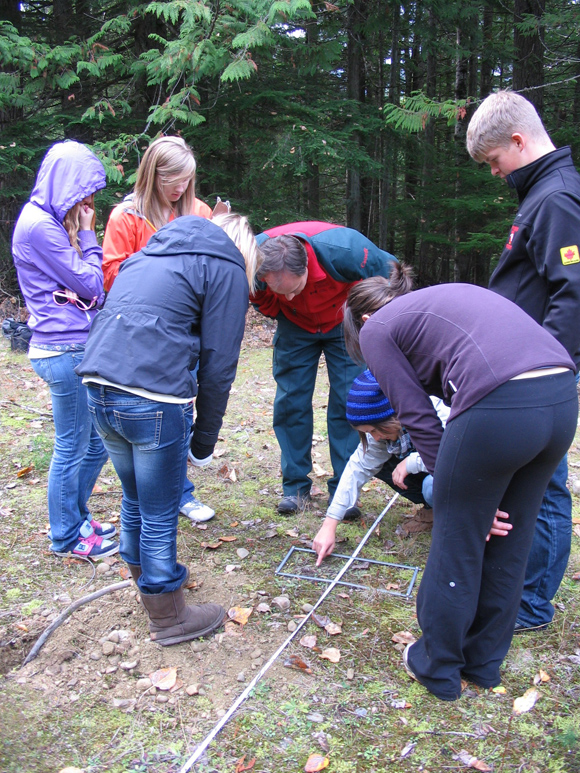
A Parks Canada Vegetation Specialist explains why restoration is important and how it relates to succession.
©Parks Canada
While seemingly pristine, national parks have highways and buildings and parking areas that impact the natural landscape. Sometimes these disturbed areas are abandoned and need to be returned to their natural state. Mount Revelstoke National Park has a one-acre site that was used to store and dump materials such as road signs, concrete barriers and gravel. While trade waste in the area was cleaned up years ago, the process of succession was slow because compact gravel at the site made it difficult for vegetation to grow.
In support of improved ecological health, Parks Canada staff worked with local Grade 10 students to restore the site by advancing the stage of succession so that it more closely resembled the natural state of the surrounding forest.
First the students observed and recorded the plant and tree species found in the surrounding natural forest and then compared their findings with the disturbed site which, they noted, contained a number of non-native species. Next, using grid lines, they systematically recorded and removed the non-native species found in the disturbed site then transplanted native hemlock and fir trees into the area.
With the help of the students, the site will be monitored over time and it is expected that the number of non-native species at the site will decrease and the number of native ones, especially more mature tree species, will increase.
DNA Wolverine Monitoring
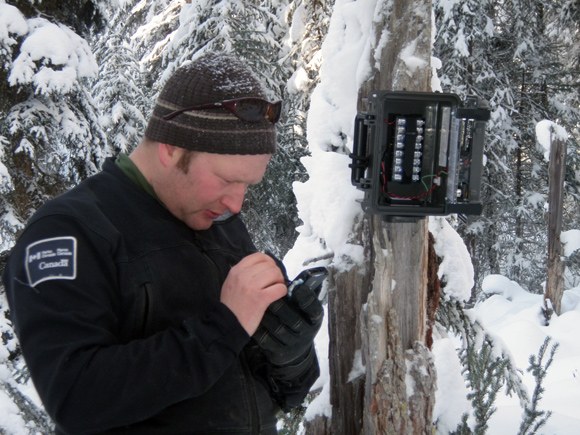
Setting up a camera to monitor wolverines.
©Parks Canada
Wolverines are Blue-listed as a species of special concern by the government of British Columbia and have been referred to the Committee on the Status of Endangered Wildlife in Canada for re-assessment. Wolverines have a low-reproductive rate and are sensitive to human activities and habitat fragmentation created by human development such as highways and railways.
In order to better understand the dispersal of this elusive species, Mount Revelstoke and Glacier national parks are piloting a wolverine DNA project to learn about the genetic exchange of wolverines across the Trans-Canada Highway and Canadian Pacific rail line in Glacier National Park.
Parks Canada staff are collecting wolverine DNA using baited barbed-wire hair traps set up on trees and the sites are monitored using infrared motion-sensor cameras. Researchers can monitor wolverine behaviour and estimate the size, gender and genetic dispersal of the population without ever having to come in direct contact with the animal. The results from the wolverine study, along with earlier data, will be used to determine future wolverine habitat and connectivity protection actions.
Studying Forest Fire Ecology
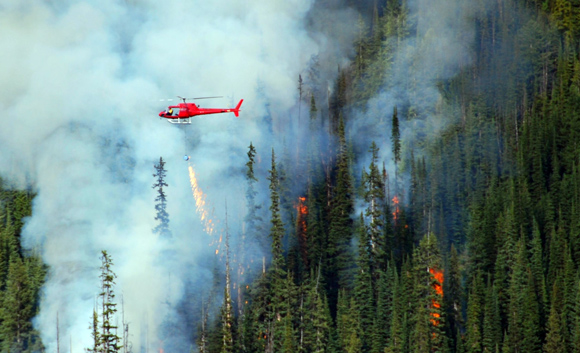
Grizzly Ridge Fire Burnout
©Parks Canada - Simon Hunt
Mount Revelstoke and Glacier national parks protect globally unique forest types and terrain found in the Columbia Mountains Natural Region. Naturally-occurring forest fires periodically disturb these forests, but the characteristics of these fires are relatively unknown.
Beginning in the 1980s, Parks Canada partnered with the University of Calgary and pioneered studies on the characteristics of forest fire in Mount Revelstoke and Glacier national parks to learn what makes these fires tick.
Parks Canada continues to research forest fire behaviour in these parks, including how and where to thin forests to protect nearby property. Using state-of-the-art science, Parks Canada is working with the Province of British Columbia Wildfire Management Branch and the Canadian Forest Service to model and map the risk of forest fire in the parks. This research helps guide Parks Canada on how to best manage forest fire for effective protection of people, property and infrastructure. It also guides Parks Canada in restoring forest fire as a natural ecosystem process to improve forest health, reduce the risks of catastrophic wildfires and provide animals with improved forage.
Related links
- Date modified :
